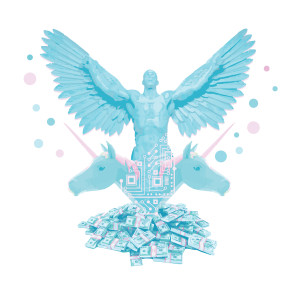Matney: Unicorns, bubbles, hubris define Silicon Valley’s race to innovate

May 4, 2015
The InterContinental Hotels Group, one of the world’s largest hotel companies, can trace its origins all the way back to 1777 and has steadily built up its business to a market cap of almost $10.1 billion. Airbnb, a 7-year-old Internet space-renting company and another leader in the industry, is in the process of fundraising that would value it at $20 billion. Welcome to the new economy.
Last May, I wrote a column detailing how, due to rampant overvaluations, Silicon Valley was headed to hell in a handbasket and the bursting of the “hashtag” bubble was just around the corner. I decried how some of the central pillars of the most rapidly accelerating industry in our economy could possibly be built simply on the promise of future advertising profits. But you know, it turned out I was wrong.
That bubble has continued to inflate and proves to be much more elastic than many others, and myself, thought possible. How has Silicon Valley possibly defied expectations this time yet again? The answer is not simple. It is largely the result of more pervasive economic factors and legislation that continues to encourage investment in the industry, but it is also the result of the valley succeeding in diversifying its impact across a wide swath of industries.
When Uber launched five years ago, it saw an opportunity to attach itself to and dominate a market that had yet to be disrupted by the digital age. It believed that taxi services had grown complacent in their shared success and had failed to bring consumers the level of innovation that could reasonably be expected. Today, Uber’s valuation leaves it at about $41 billion. It has achieved a Fortune 500-equivalent valuation in just a few years by championing an intuitive interface with simple payment options made possible by the proliferation of smartphones.

The lingering question plaguing investor and venture capitalist minds is whether valuations like Uber’s and Airbnb’s are realistic. When Facebook was valued at $104 billion upon going public in 2012, investors faced the same question only to kick themselves years later as they realized how much they had low-balled Facebook’s potential for growth. Three years later, Facebook is the 13th most valuable U.S. company with a market cap of almost $225 billion.
The lessons of Facebook have majorly influenced the amount of money pumped into the valley. In January, Fortune estimated more than 80 privately held companies had been given “unicorn” status by venture capitalists, meaning valuations of $1 billion or more. Many of these companies have been founded in the past several years while others are more than a decade old and are just now managing to find their major investors.
With this massive influx of funds comes a fear of flying too close to the sun. These unicorns are forcing investors to speculate about how many of these 80 companies with hundreds of millions — and in some cases, billions — of venture capital funding are going to survive. Could a few dead unicorns kill the Icarian Silicon Valley, or is it on the fast track to spreading its innovation across so many industries that it effectively becomes bubble-proof?
What’s so intensely exciting about Silicon Valley right now is that it appears the latter option is now more feasible than ever. The transportation sector is one of the most apparent cases of this, where new consumer technologies are rapidly changing the underlying tenets of how the entire industry operates. With ride-sharing powered by Uber and Lyft, self-driving vehicles powered by Google and ultra-efficient battery technologies pursued and researched by Tesla, among others, we may be at the cusp of a breaking point due solely to the innovation of the valley.
With the advent of so many amazing technologies, ones that are gaining funding at heightening rates, it’s easier for me to express optimism in the future of Silicon Valley. All bubbles must eventually burst or deflate, but if the valley can continue to diversify its innovation into revamping major industries’ ways of doing business, then the destruction will in no way match that of the dot-com bubble crash of 2000. That being said, assured growth and risk-free speculation beget recklessness and greed as we see in markets like these time and time again, so it would be wise for investors and founders not to fully forget the sins of the past. Regardless, it will be exciting to see how many industries this crazy place touches as it flies toward the sun before eventually either crashing down or launching a revolutionary update to its obsolete wings.
Lucas Matney is a Medill junior. He can be reached at [email protected]. If you would like to respond publicly to this column, send a Letter to the Editor to [email protected].

